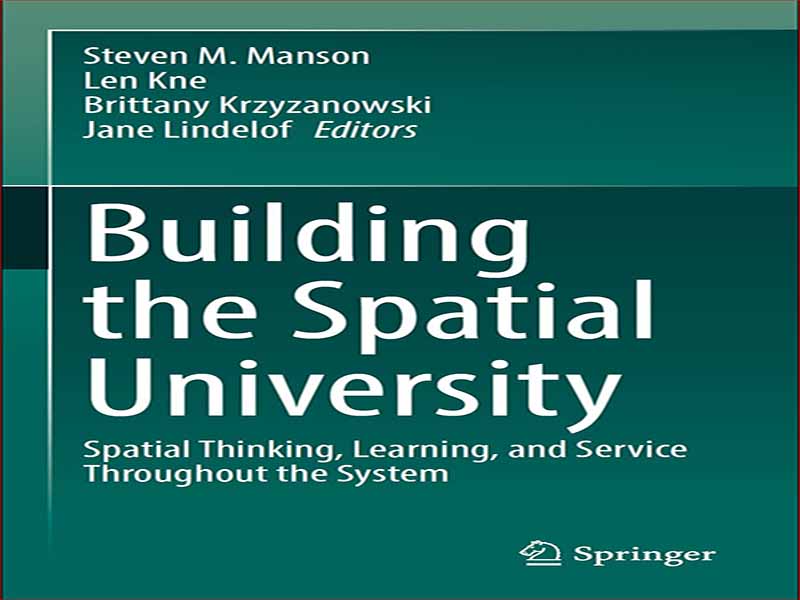- عنوان کتاب: Building the Spatial University
- نویسنده: Steven M. Manson
- حوزه: دانشگاه
- سال انتشار: 2022
- تعداد صفحه: 129
- زبان اصلی: انگلیسی
- نوع فایل: pdf
- حجم فایل: 2.57 مگابایت
این جلد مجموعه وسیعی از دانش و عمل را در مورد چگونگی تشویق موسسات به تحقیق، آموزش و خدمات فضایی خلاصه می کند. ما این کار را تا حد زیادی توسعه دادیم زیرا ویراستاران و سایرین در دانشگاه مینهسوتا تعداد فزایندهای از پرس و جوها را درباره نحوه حمایت ما از تحقیقات، آموزش و خدمات فضایی ارائه میکردند. با یک زمان بندی خوب، زاخاری رومانو، در آن زمان ویراستار و اکنون سردبیر ارشد انتشارات با مجموعه علوم زمین، جغرافیا و محیط زیست در اسپرینگر ساینس، چند سال پیش در کنفرانس کاربران Esri به لن کن نزدیک شد و از او پرسید که آیا این کار را انجام خواهد داد. با هم یک جلد در U-Spatial، زیرساخت علوم فضایی دانشگاه. با درک اینکه ویرایش یک جلد میتواند هم سرگرمکننده و هم خستهکننده باشد، لن به استیون منسون ضربه زد و آنها نیز به نوبه خود، بریتانی کریزانوفسکی و جین لیندلوف را آوردند تا در شادی و درد شریک شوند. ما فکر می کردیم که این جلد در درجه اول درباره U-Spatial باشد که موضوع فصل است. 2 و در سراسر این جلد بافته شده است. با این حال، همانطور که با خوانندگان و نویسندگان بالقوه درگیر شدیم، مشخص شد که ما واقعاً به ایده گسترده تر دانشگاه فضایی علاقه مندیم. این جلد دیدگاه گستردهای در مورد قدرت و امکان علم فضایی برای تحقیق، تدریس و اطلاعرسانی برای محققان و مؤسسات به طور گستردهتر ارائه میدهد. نقش فضایی تقریباً در همه حوزههای آموزش عالی آشکارتر شد زیرا همهگیری COVID-19 بسیاری از مردم را مجبور کرد که از فناوری به عنوان راهی برای عبور از بسیاری از جنبههای بحران استقبال کنند. با توجه به این تمرکز گستردهتر بر دانشگاه فضایی، ما در ابتدا دو مخاطب اصلی را برای این کتاب متصور بودیم، و آنها در سرتاسر جلو و مرکز باقی ماندند. اولین مورد، پزشکان و رهبران علوم فضایی هستند که در نهادهای دانشگاهی کار می کنند. دوم، طیف وسیعی از فناوری اطلاعات، کارخانه فیزیکی، مدیریت امکانات، کتابداران، و مدیران تحقیقاتی در آموزش، دانشگاه، و مجموعهای از بخشهای دیگر است که به دنبال بینش و جهتگیری در توسعه زیرساختهای علوم فضایی هستند. در کنار هم گذاشتن جلد، مشخص شد که دیگران می توانند از این جلد بهره ببرند. این کار می تواند منبعی برای محققان فضایی و دست اندرکارانی باشد که علاقه مند به دیدگاه گسترده ای در مورد علوم فضایی هستند زیرا در طیف وسیعی از حوزه ها کاربرد دارد. همچنین می تواند به دانشجویان فارغ التحصیل در طیف وسیعی از زمینه ها کمک کند که با توسعه یا کار با داده ها و تجزیه و تحلیل مکانی در تحقیقات خود دست و پنجه نرم می کنند، از جمله دانشجویان کارشناسی ارشد در علوم اطلاعات جغرافیایی (GISc)، علم اطلاعات، یا علم کتابداری. از نظر مخاطبان خاص حوزه، دانشمندان علوم اجتماعی و دانشمندان علوم انسانی همواره به نقشهبرداری و فضا علاقه داشتهاند، اما افزایش دید و اهمیت اخیر دادهها و رویکردهای مکانی، علم و زیرساخت فضایی را در خط مقدم بسیاری از زمینهها قرار داده است. ما همچنین شاهد افزایش علوم انسانی دیجیتال و علوم انسانی زیست محیطی هستیم – حوزه هایی با علاقه به علوم فضایی به عنوان یک رویکرد روش شناختی و فنی و همچنین موضوع مطالعه انتقادی. دانشمندان زمین، سیارهشناسی، بومشناسی، و دانشمندان نقش علوم فضایی را در مطالعه زمین به عنوان یک سیستم یکپارچه انسان و محیط زیست پذیرفتهاند. این محققان از داده ها و رویکردهای مکانی برای مطالعه فرآیندهای اقیانوس، زمین و جو استفاده می کنند. در نهایت، بسیاری از تحقیقات فضایی توسط دانشمندان و مهندسان اطلاعات، داده ها و کامپیوتر انجام می شود. این جلد به این محققین یک دید کلی از چالش ها و فرصت های عمده در علوم و زیرساخت های فضایی ارائه می دهد. در حالی که ما معتقدیم که بسیاری از گروههای مختلف مردم ارزشی را در این جلد خواهند یافت، هدف بزرگتر ما نشان دادن راههای متعددی است که از طریق آنها علوم و زیرساختهای فضایی در بسیاری از زمینههای تحقیق، تدریس و خدمات یکپارچه هستند. با توجه به گستردگی مثالها، این حجم باید برای کسانی که در بخش خصوصی، سازمانهای غیرانتفاعی و سازمانهای دولتی هستند صحبت کند. امیدواریم برای سالهای آینده در این طیف از پرس و جو و تمرین مفید و قابل درک باشد.
This volume summarizes a large body of knowledge and practice on how institutions can encourage spatial research, teaching, and service. We developed this work in large part because the editors and others at the University of Minnesota were fielding an increasing number of inquiries about how we support spatial research, teaching, and service. By a stroke of good timing, Zachary Romano, then Associate Editor and now Senior Publishing Editor with the Earth Sciences, Geography, and Environment portfolio at Springer Science, approached Len Kne at the Esri User Conference a few years ago and asked whether he would put together a volume on U-Spatial, the University’s spatial science infrastructure. Realizing that editing a volume can be both fun and frustrating, Len tapped Steven Manson, and they in turn, brought in Brittany Krzyzanowski and Jane Lindelof to share the joy and pain. We thought this volume would be primarily about U-Spatial, which is the subject of Chap. 2 and woven throughout this volume. As we engaged with potential readers and authors, however, it became clear that we are really interested in the broader idea of the spatial university. This volume offers an expansive view on the power and possibility of spatial science for research, teaching, and outreach for scholars and institutions more broadly. The role of spatiality in almost all realms of higher learning became even more evident as the COVID-19 pandemic forced so many people to embrace technology as a way to navigate many facets of the crisis. Given this broader focus on the spatial university, we originally envisioned two primary audiences for this book, and they remained front and center throughout. The first is spatial science practitioners and leaders who work within academic institutions. The second is a range of information technology, physical plant, facilities management, librarians, and research administrators in education, academia, and a host of other sectors who are looking for insight and direction on developing spatial science infrastructure. In putting the volume together, it became clear that others could benefit from this volume. This work can be a resource for spatial researchers and practitioners interested in a broad view on spatial science as it applies to a range of domains. It can also aid graduate students in a range of fields who are grappling with developing or working with spatial data and analysis in their research, including master’s students in geographic information science (GISc), information science, or library science. In terms of domain-specific audiences, social scientists and humanities scholars have always had an interest in mapping and space, but the recent increased visibility and importance of spatial data and approaches has placed spatial science and infrastructure at the forefront of many fields. We are also seeing an increase in the digital humanities and environmental humanities—areas with an interest in spatial science as both a methodological and technical approach, as well as a subject of critical study. Earth, planetary, ecological, and natural scientists have embraced the role of spatial science in the study of the earth as an integrated human–environment system. These researchers use spatial data and approaches to study ocean, land, and atmosphere processes. Finally, much spatial research is performed by information, data, and computer scientists and engineers. This volume gives these researchers an overview of the major challenges and opportunities in spatial science and infrastructure. While we believe that many different groups of people will find value in this volume, our larger goal is to demonstrate the many ways in which spatial science and infrastructure are integral to many areas of research, teaching, and service. Given the breadth of the examples, however, the volume should speak to those in the private sector, non-profit organizations, and governmental organizations. We hope it will be useful and comprehensible across this range of inquire and practice for years to come.
این کتاب را میتوانید از لینک زیر بصورت رایگان دانلود کنید:
Download: Building the Spatial University



































نظرات کاربران